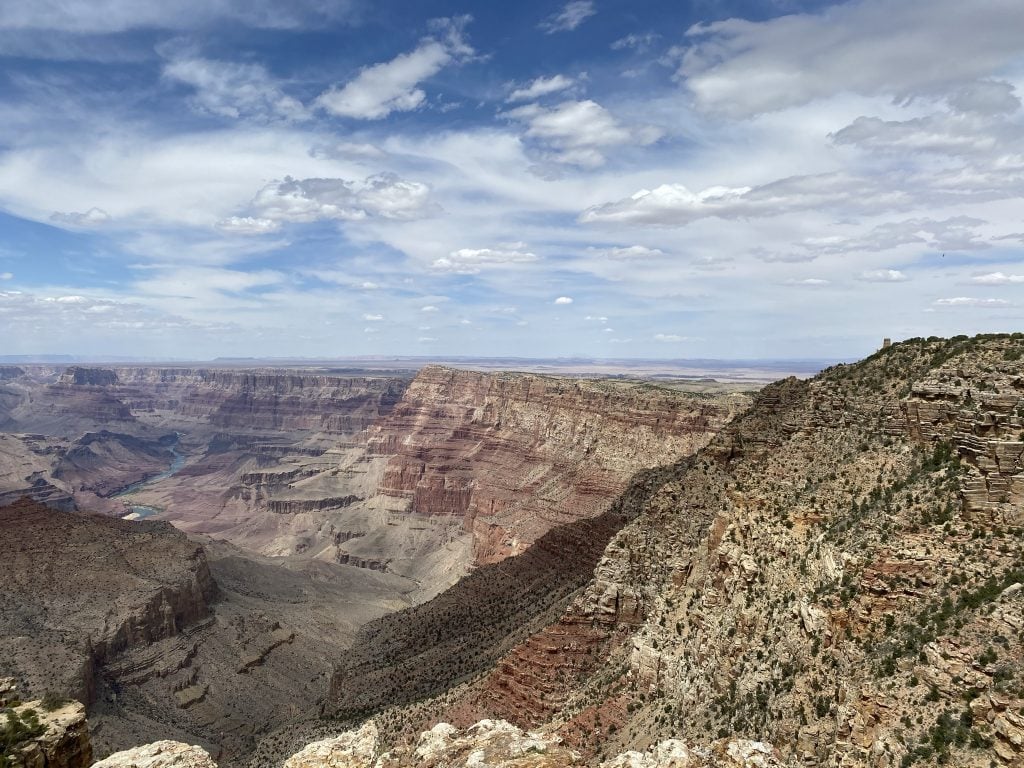
In 1919, Congress passed An Act to Establish the Grand Canyon National Park in the State of Arizona. Today, the mile-deep, 277-mile-long canyon and over one million acres attract over 6 million visitors a year.
“Leave it as it is. You cannot improve on it. The ages have been at work on it, and man can only mar it. What you can do is to keep it for your children, your children’s children, and for all who come after you, as the one great sight which every American should see.”
Theodore Roosevelt
While the Grand Canyon can be your destination point, it can also be part of several road trips. We included it as part of our Grand Circle Loop which includes Utah’s Mighty 5 National Parks. Another option includes a loop between Phoenix, Flagstaff, and the Grand Canyon. Or you might simply visit as part of a day trip from Flagstaff.
The Grand Canyon has three regions, The Colorado River/Canyon Floor, North Rim, and the most visited, South Rim. This guide will cover a South Rim visit.
How to Get to the Grand Canyon – South Rim
East Entrance
Traveling from the East, travel north or south on US 89 to the intersection at AZ 64, Cameron. Stop at the Historic Cameron Trading Post for a break or meal. From Cameron to the East Entrance is 34 miles. Once in the park, enjoy the 23-mile-long Desert View Drive to the main Visitor Center. When we visited in mid-May, we were third in line at the entrance with minimal wait.
South Entrance
The South Entrance is the primary point of entry to the South Rim. This entrance is 5 miles north of Tusayan and 55 miles north of Williams, AZ on AZ 64.
West Entrance
The closest entrance to the park from the Las Vegas area is found at the West Entrance. The 126-mile drive will take just over 2 hours.
Visitors should note, however, that Grand Canyon West is not administered by the rest of the park, but by the The Hualapai Tribe, whose land this section of the Grand Canyon lies upon; as such, entrance fees for Grand Canyon West are only good for Grand Canyon West.
Train
Grand Canyon Railway operates routes from Williams, AZ to the South Rim’s Grand Canyon Village. The 2-hour trip includes musicians, staged robberies, and shoot-outs. Ticket prices are tiered for coach or first class. Children under 15 are not allowed in the Observation Dome or Luxury Parlor Class.
How to Get around the Grand Canyon
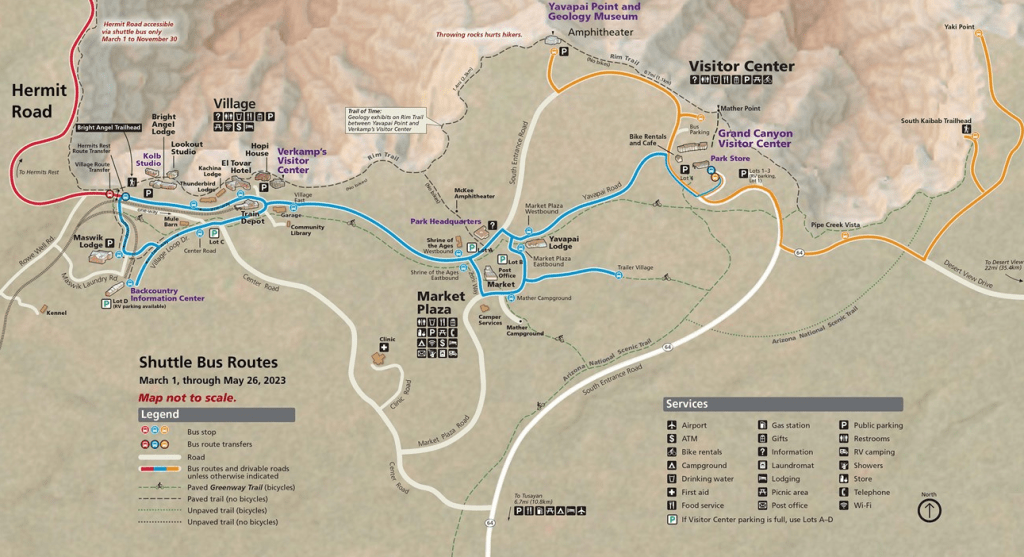
Free Shuttle Buses
- Hermits Rest Route (Red) – runs from March 1 to November 30
- Kaibab/Rim Route (Orange) – runs year-round
- Village Route (Blue) – runs year-round
- Tusayan Route (Purple) – runs from early spring to fall
- Hiker’s Express Bus – one-way, early morning bus (5, 6, and 7 am – May and September or 4, 5, and 6 am in June, July, and August) running from Backcountry Information Center to South Kaibab Trailhead
Walking and Bicycle Paths
- Rim Trail is a 12.8-mile paved walking path along the canyon rim between Hermit Trailhead to South Kaibab Trailhead
- Greenway Trail is a 13-mile paved walking and bike path between South Kaibab Trailhead to the Visitor Center and out of the park to Tusayan.
By Car
- Parking is available at Desert View.
- 3 Parking lots are available at the Visitor Center with access to 3 shuttle bus lines. (Blue, Purple, and Orange)
- Parking Lot A at Park Headquarters located in the Market usually fills by noon. Access to Village Route shuttle bus (Blue line)
- Parking Lot B is located at the market at Market Plaza with access to the Village Route shuttle bus (Blue line), which usually fills by noon.
- Parking Lot C in the Village usually fills by 2 pm. Has access to the Village Route shuttle bus (Blue line).
- Parking Lot D near the Backcountry Information Center in the Village has access to the blue line. Lot usually fills by 2 PM.
In the Grand Canyon, Arizona has a nature wonder which is in kind absolutely unparalleled thorughout the rest of the world.
Theodore Roosevelt
Best Overlooks
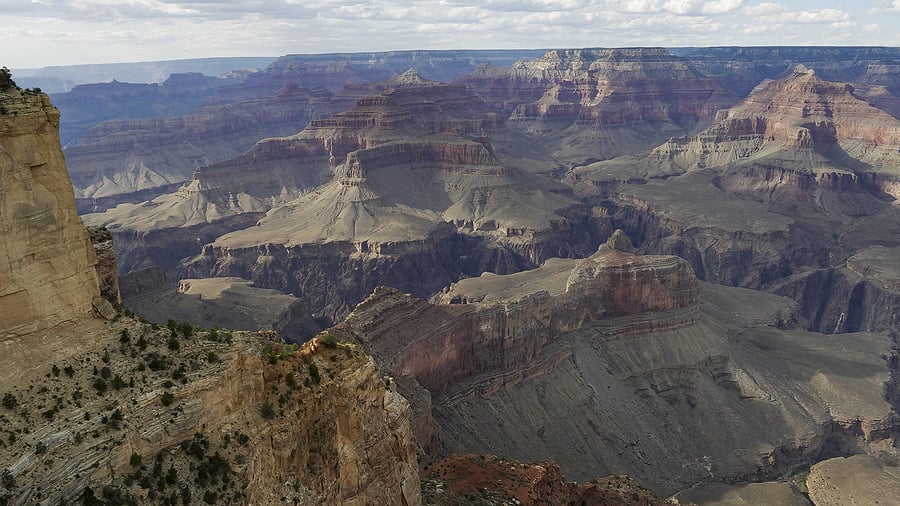
Maricopa Point
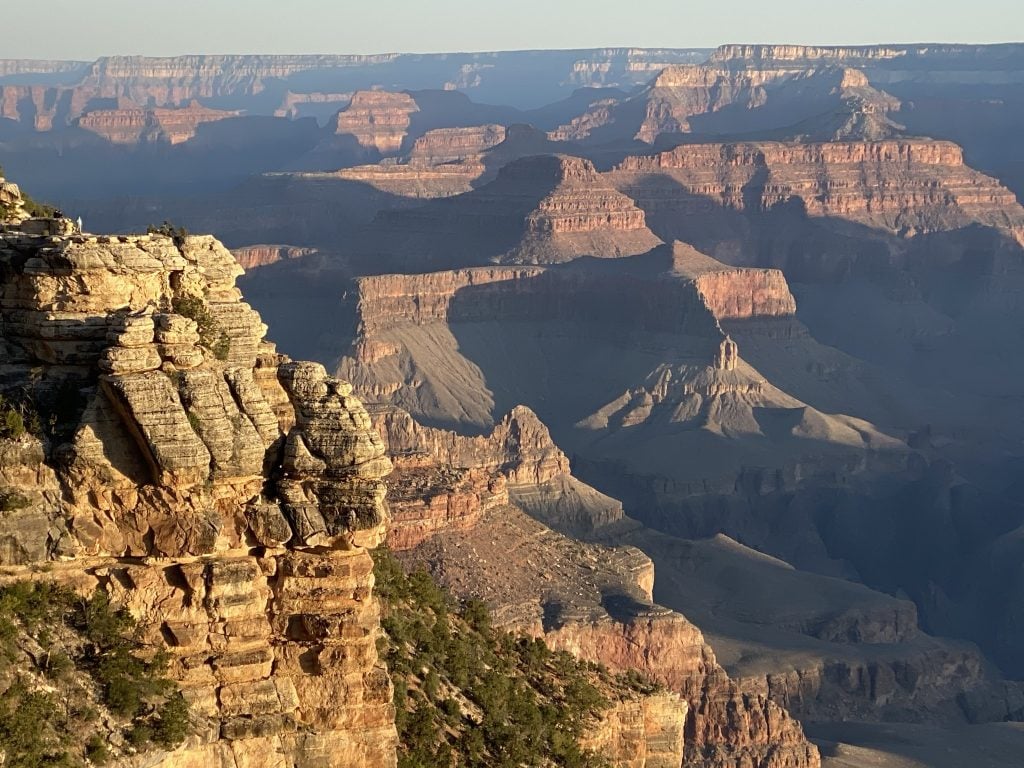
Mather Point
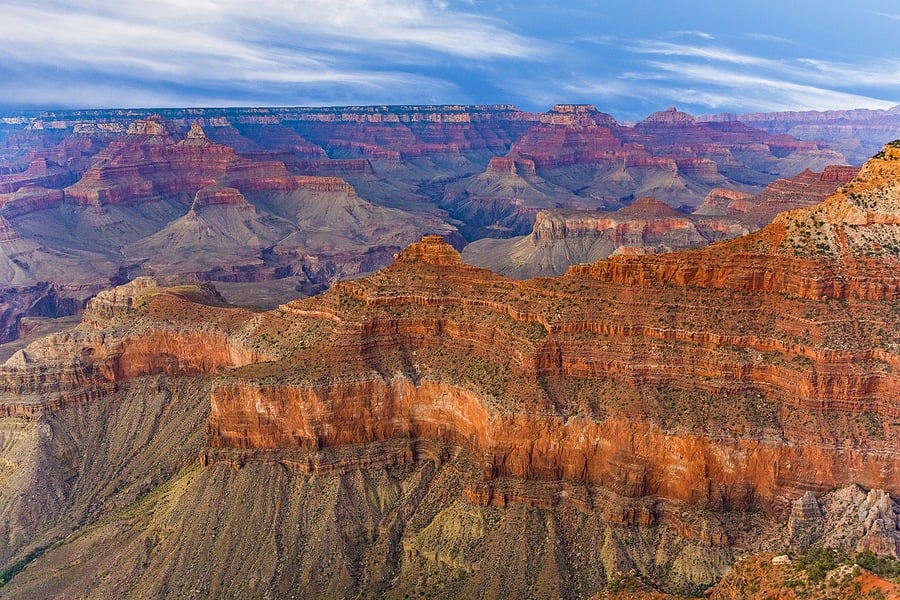
Yaki Point
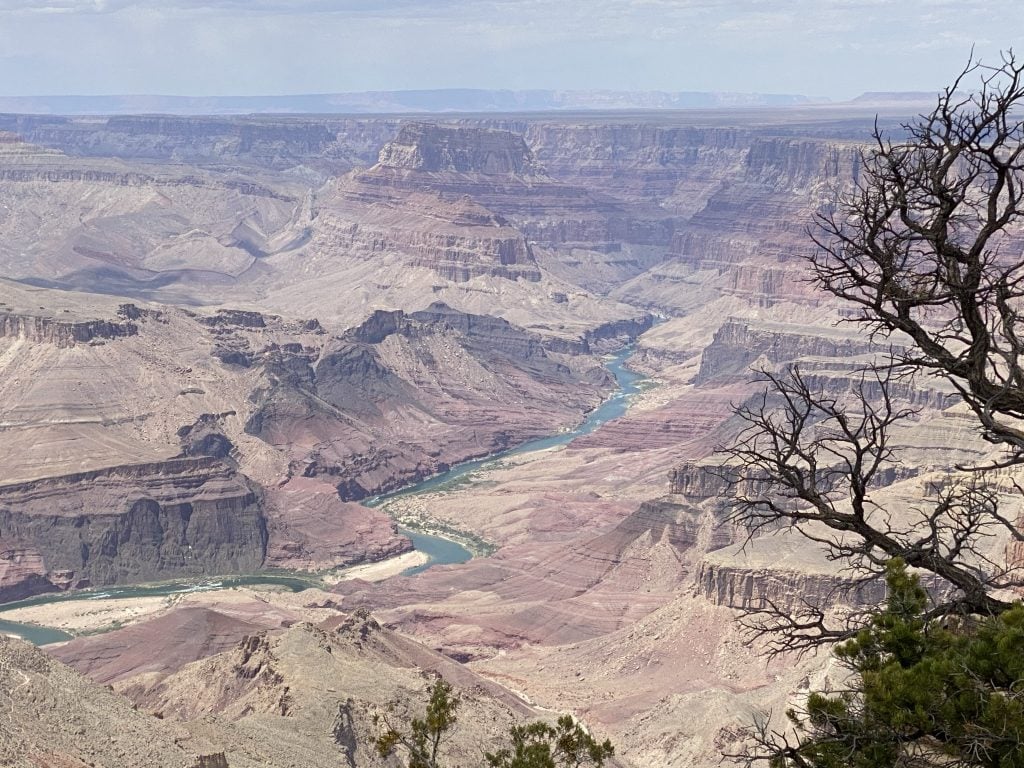
Desert View
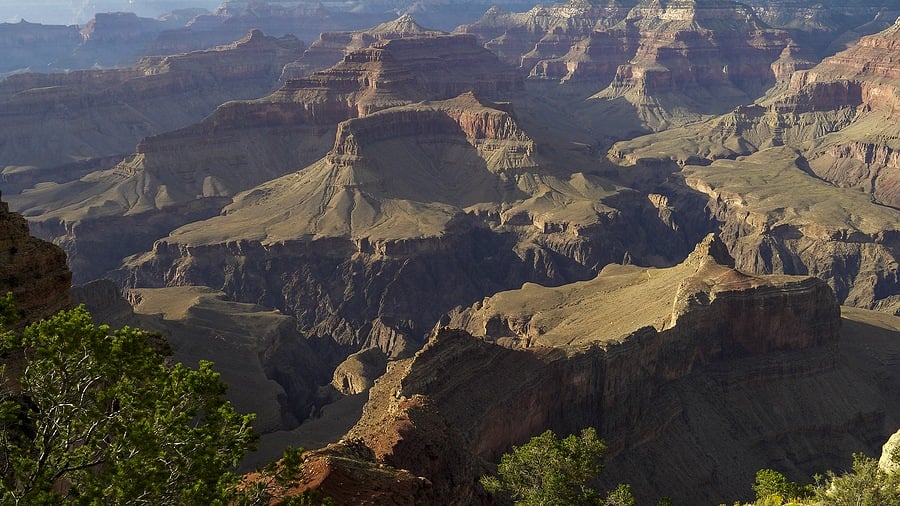
Powell Point
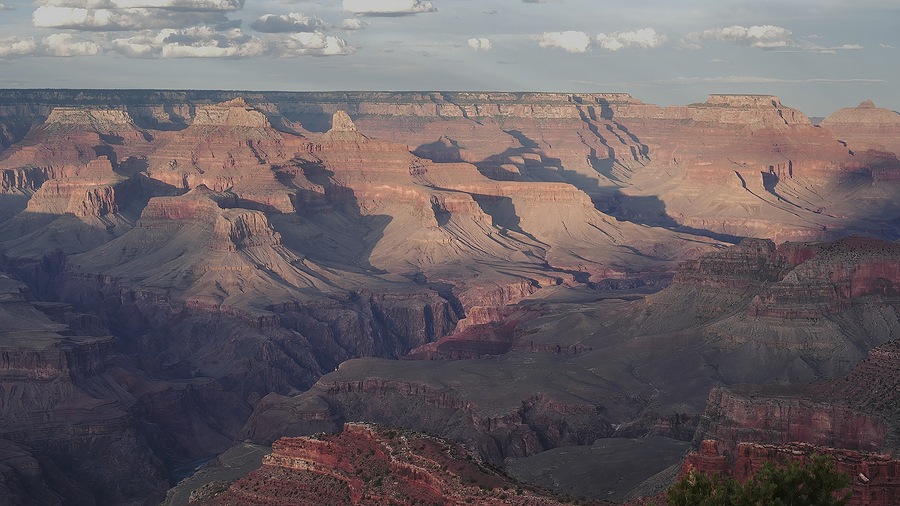
Hopi Point
Grand Canyon South Rim Hikes
Easy
- Rim Hiking Trail 0-12.8 miles. Mostly flat with easy walks and quiet views. Many sections are suitable for wheelchairs or strollers. Mostly paved except dirt section from Monument Creek Vista east to Powell point.
Strenuous
- Hermit, 10.3 miles. Unmaintained trail to the Colorado River.
- Bright Angel, 9.6 miles. A popular but steep trail into the canyon. Hikes down to 1 1/2-Mile Resthouse, 3-Mile Resthouse, and Indian Garden
- South Kaibab, 7.3 miles. Day hikes down to Ooh Aah Point, Cedar Ridge, and Skeleton Point, a steep trail with no water or shade.
- Grandview, 3.2 miles. While short, this trail is recommended for very experienced hikers.
Activities at the Grand Canyon: Visitor Centers, Museums, Skywalk, IMAX Theater
Fill out your Grand Canyon visit itinerary with the following activities:
- Kolb Studio – Historic photographic studio of brothers Ellsworth and Emery Kolb where you’ll find information, exhibits, and passport stamp.
- Verkamp’s Visitor Center – Built in 1906 by Ohioan John George Verkamp who sold Native American crafts and souvenirs.
- Yavapai Geology Museum – Bookstore and museum shop with large picture windows for viewing the canyon. Check out the topographic relief map of the canyon.
- Canyon View Information Plaza – Located near Mather Point, explore the exhibits, buy books, and take a bathroom break.
- Tusayan Ruins and Museum – View 2000 to 4000-year-old artifacts and traditional handicrafts made by ancestral Puebloans at this free museum.
- Desert View Visitor Center – information, Hopi murals, passport stamp, cultural demonstrations
- Skywalk – Horseshoe-shaped cantilever bridge with a glass walkway in the Grand Canyon West area.
- IMAX Theater – Giant six-story screen movie experience showcasing the Grand Canyon’s history.
- Junior Ranger program – Earn your Junior Ranger badge at the visitor center by completing a free activity book.
- Mule trips – Enjoy a 2-hour Canyon Vistas Mule Ride. Riders must be 9 years of age, at least 57 inches tall, and weigh less than 200 lbs.
- More tours, activities, and things to do in the Grand Canyon.
Where to Eat in the Grand Canyon
- Bright Angel Bicycles & Cafe at Mather Point – prepackaged sandwiches and breakfast burritos
- Bright Angel Lodge – two restaurants, one casual dining, and one Arizona cuisine
- Canyon Village Market & Deli “General Store” – breakfast sandwiches and burritos, sandwiches, salads, pizza
- El Tovar Hotel – breakfast, tapas, soups, salads, fine dining.
- Hermits Rest – prepackaged sandwiches, cookies, ice cream, trail mix
- Maswik Lodge – food court, pizza pub
- Yavapai Lodge – pizza, salads, sandwiches, and BBQ
- Desert View Market Deli – breakfast sandwiches and burritos, sandwiches, salads, hot dogs
- Desert View Trading Post – coffee and ice cream
How Many Days Do You Need at Grand Canyon National Park?
Depending on how active your big family is, you can plan a one-day visit, a two-day visit, or even a week at the Grand Canyon. With so much to do, don’t overbook your days, extend your visit an additional day or two.
One-Day Itinerary
Entering from the East Entrance, we recommend the following:
- Stop at Desert View to explore the Watchtower and get your first glimpse of the Canyon.
- Drive to the main Visitor Center, stopping at Navajo, Lipan, Moran, and Grandview Points
- Visit Mather Point and stop at the visitor center to let the kids earn their Junior Ranger badge
- Walk parts of the Rim Trail for different views of the canyon
- Visit the Yavapai Point Geology museum
- Explore the Village and walk the Rim Trail
- Visit the Lookout Studio and Kolb Studio
- Walk past the Train Depot and the Mule Barn
Two-Day Itinerary
Follow the one-day activities above and add in the following activities on the second day:
- Ride the Hermit Road Shuttle Bus to visit Maricopa, Powell, Hopi, Mohave, and Pima Points
- Visit the IMAX theatre or rent bikes to explore the bike paths
Fun Fact: There are an estimated 1000 caves in the canyon, 335 have been recorded. Only one cave, Cave of the Domes, is open to the public.
Entrance Fees for Grand Canyon National Park
We highly recommend buying an America the Beautiful pass for $80. The pass is good for one calendar year and is your ticket to more than 2,000 federal recreation sites. Having a pass will allow you to pop in for a few hours in the evening and again the next morning.
If you have a 4th grader, check out the FREE Annual 4th Grade pass which is good for the duration of the school year through the following summer (September-August).
Current U.S. military members and their dependents in the Army, Navy, Air Force, Marines, Coast Guard, and Space Force, as well as Reserve and National Guard members, qualify for a free annual pass.
What is the Best Time to Visit the Grand Canyon?
The least crowded time to visit is November through February, although winter weather should be considered when planning a visit.
Summer Visits
Plan for brutal heat in the inner canyon while up on the rim, dramatic changes in temperatures during the day will require clothing layers. Be aware of lightning danger during the months of June through August.
Spring and Fall Visits
Late April and May can see strong winds on the rims. Our visit in mid-May required us to bundle up against the cold wind. Snow can fall on the rim in May and October. Seasonable weather offers great conditions for hiking.
Winter visits
During November through March, the park snow plows South Rim roads but roads may be temporarily closed.
What is the closest town to the South Rim of the Grand Canyon?
The closest towns to the South Entrance of the Grand Canyon are Tusayan, Grand Canyon Junction, and Williams. If you enter using the East Entrance, the closest town is Cameron, AZ
Which is best to visit the North or South Rim of the Grand Canyon?
Most people, 90% of visitors, visit the South Rim. Proximity to Interstate 40, a local airport, rail service, and being open all year make this rim the popular choice. However, since the North Rim is considered harder to get to, you will find fewer crowds during the shorter season of May 15 through October 15. The closest towns to the North Rim Village include Fredonia, Arizona and Kanab, Utah.
15 Tips for Visiting the Grand Canyon
- Expect crowds, the park receives more than 6 million visitors a year. You might feel that they all visit at the same time you do – ha!
- The South Rim averages 7000 feet above sea level. Take the elevation into consideration when visiting, rest when needed, and drink plenty of water.
- Summer thunderstorms in July-September should be taken seriously. During these months check the weather for potential storms and plan your activities to minimize your exposure to thunderstrikes during storms.
- Be patient with bus shuttles during the busiest park seasons and the busier times of the day. You may have to wait for several shuttles before you can board.
- Baby-back carriers need to be removed when riding shuttles.
- Bring layers to wear. The desert environment means big changes in temperature from morning to afternoon to evening. When we visited in mid-May, the afternoon only required a light jacket but dusk temperatures required another layer. Sunrise viewings will require more layers than afternoon visits. Our sunrise visit was very windy out on Mathers Point.
- Many areas do not have fences or guard rails. Use the buddy system to assign kids to parents to help alleviate any constant worry about how close everyone is to the drop-offs.
- For smaller kiddos, pack a stroller to help control any runners you might have. The 13-mile Rim Trail is paved and stroller-friendly.
- I recommend arriving at the park mid-afternoon to drive to the viewpoints and enjoy the sunset. Stay inside the park and plan on an early morning sunrise viewing the next day at your favorite viewpoint. You might have a few cranky kiddos but you can schedule a nap for everyone later that day.
- When hiking, remember to take a 10-minute break at least once an hour. Hydrate and eat energy snacks.
- If you plan to do any overnight backpacking, advance permit requests are accepted four months prior to the proposed start month. Groups are restricted to 11 or fewer people.
- Know your crew and set realistic expectations for visiting. If you’re an outdoor family that loves to hike, that’s great – plan several hikes that match your abilities! On the other hand, know that there’s nothing wrong with visiting the park without hiking at all.
- The only gas station in the park is at Desert View on the east side.
- Wi-Fi availability – Bright Angel Lodge (fee), Camper Services, Canyon Village Market & Deli “General Store”, Community Library, El Tovar Hotel (fee), Maswik Lodge (fee), Park Headquarters, and Yavapai Lodge.
- For the best pictures at sunrise and sunset, point your camera in the opposite direction of the sun. Then your photos will show the lights on the rocks below.
Where to Stay
Hotels for big families
- Inside the Park
- There are five hotels on the South Rim but none of them sleep six or more. If you want to stay in a hotel, you will need to book 2 rooms.
- Although I don’t like booking two rooms, there are benefits of staying inside Grand Canyon Park:
- Parking outside your room. No need to worry about full parking lots.
- Walking trails from hotels give easy access to all the points.
- Easily attend a sunrise viewing without having to wait in line to get into the park and save time by just waking up and walking to your favorite viewpoint.
- Outside the Park
Camping and RV
- Inside the Park
- Mather Campground – Each of the 327 campsites includes a ring/cooking grate, picnic table, parking space, and room for up to six people. Campsites allow 3 tents and two vehicles. Flush toilets and drinking water are available. RV spaces are pull-through but no hookups are available. A free dump station is included.
- Trailer Village RV Park – The only in-park RV campground with full hookups. Open year-round, pull-through sites can accommodate vehicles up to 50 feet long. Reservations can be made 13 months in advance.
- Desert View – 50 campsites available. Most are sized to accommodate tents, smaller RVs, and vehicles with trailers of up to 30 ft total length.
- Outside the Park
- Ten-X Campground – Open May 14th through September 30th. The site has pit toilets, cold water faucets, and, no hook-ups or showers.
- Grand Canyon Camper Village – Commerical campground located 7 miles south of Grand Canyon Village.
Vacation Rentals
If you’re looking for more room or staying for more than a few days, a vacation rental near the Grand Canyon will be the way to go. However, offerings near the South Rim and the south entrance to the park are few. More options are located in Williams and Flagstaff. You will have to decide if the extra space is worth the increase in your drive time into the park.
You might also Like:
Canyonlands National Park Guide with Kids Plus 10 Tips to Help You Plan Your Trip
Big Family Guide to Arches National Park with Kids – What You Need to Know to Plan Your Trip Plus 12 Tips
Grand Canyon’s North and South Rims, East and West Entrances – Which to Visit
Ultimate Road Trip With Kids – Las Vegas to Zion National Park via the Grand Canyon
12 Tips and Complete Guide to Mesa Verde National Park
Pin it for Later!

